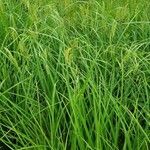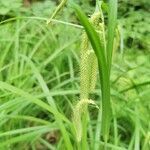Plants cespitose. Culms acutely angled, 40–150 cm, scabrous. Leaves: basal sheaths red-brown or brown; sheaths of proximal leaves bladeless, glabrous, fronts red-brown to copper-brown, spots absent, indistinctly ladder-fibrillose, apex U-shaped; blades hypostomic, abaxially papillose. Proximal bract longer than inflorescence, 3–6 mm wide. Spikes usually pendent; staminate 1–3, base cuneate or attenuate. Pistillate scales pale to copper-brown, midvein reaching apex, broad, apex of body retuse, aristate. Perigynia divergent, pale brown, inflated, loosely enclosing achenes, obovoid, dull, apex rounded, obtuse or truncate, glabrous. Achenes constricted on one or both margins or lacking constrictions; style base straight.







